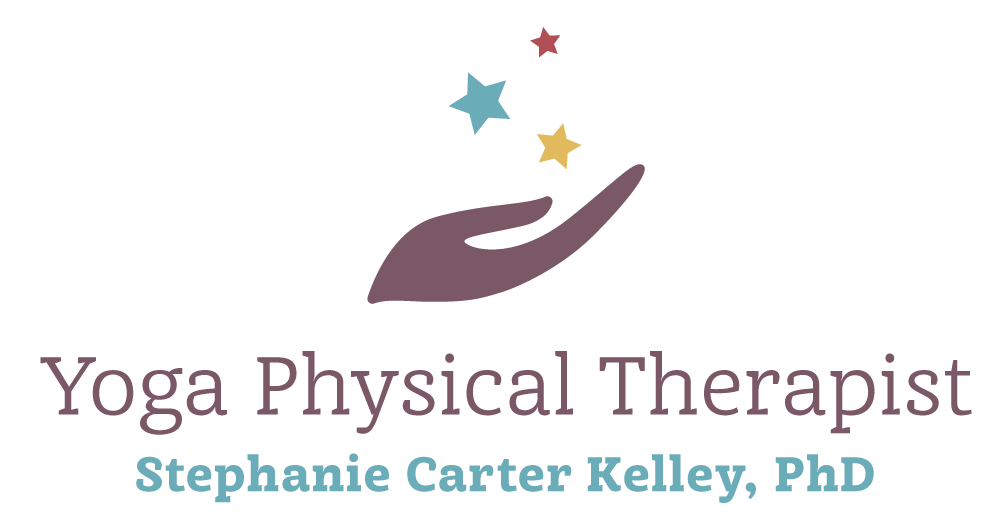I want to share my approach to teaching yoga for spine health. I have been studying and teaching about treatment of the spine as a physical therapist and educator for many years. Early in my career I felt a special affinity for treating those with back pain and neck pain. From those many years, I have developed educated assumptions to develop the classes and guide you through a spine safe yoga class.
1. Degenerative changes
Since I teach a class called “Yoga for Spine Health”, I assume that everyone that walks in has spine pain and some degenerative changes which are actually normal age-related changes. I provide cues and do poses that respect these normal age-related changes. As a physical therapist I am not scared of these normal age-related changes and I try to relieve some fear of movement for those that attend my classes. The diagnoses associated with normal age-related changes sound scary and incite fear among us, i.e. degenerative discs, herniated discs, degenerative joints, slipped discs (really no such thing, it's not like a hockey puck!), and stenosis. Fear may actually be creating the pain, rather than the normal age-related changes. We know from research on CT and MRI studies of the spine, that many people who have these same normal age-related changes DO NOT have pain. Check out the following graph. If you just look at disc degeneration (blue horizontal bar), you can see the increase in prevalence (percentage along the X axis) of this condition with age. This research showed that 37% of those in their 20's and nearly 100% of those in their 80's have disc degeneration but NO PAIN.
2. Stiffness and loss of normal motion of related areas due to habitual postures
Sitting in front of a computer is the predominate work posture these days. I am seeing an epidemic of spines stuck in flexion or a rounded posture. Many people have lost the ability to extend or backward bend due to stiffness and many times this motion is perceived as painful. But since most everyone has spent the day in flexion, it is my obligation to move you gently into the opposite direction. I take the approach that backward bending comes from the hips and the entire spine. So I lead poses that open the hips, open the thoracic spine, and then create backward bending. And I give homework: “Extend your spine everyday”.
Another thing to realize is that stiffness is different from tightness. Many people have range of motion that they just don’t use on a regular basis. So gentle repetitions of Cat/Cow and a Rocking Low Lunge help to access motion that hasn’t been used that day.
3. Muscle tension comes from stress
Many people complain that their back feels tight which usually leads to self-treatment of stretching. The one commonly used treatment that doesn’t ever do well for relief of back pain is stretching. I am beginning to believe more and more that this excess muscle tension is a symptom of chronic stress. For some people the stress resides in their shoulders and neck. For others the stress resides in the muscles that run up and down the spine. For some people, the tension resides in their “upper butt” or “piriformis”. While lengthening these muscles in a stretch position feels good while you are doing it, if you don’t address the root of the problem, i.e. chronic stress, then it comes back over and over again.
My classes consist of 2-3 stretches. I know! Many of you think that yoga is all about stretching. But I tend to focus on postural alignment, proper muscle activation, and strengthening. However, most poses do consist of both “holding” and “letting go”. The “holding” is an isometric muscle contraction to strengthen and the “letting go” is lengthening, almost stretching, the opposite muscle.
4. Poor core activation (i.e. control) and general weakness
Before you can strengthen the correct muscle or group of muscles, you must make sure that it turns on. Our body is great at performing an action with whatever muscle/s it can. For example, the hamstring loves to help extend the hip. But it is really best done by the large gluteus maximus. If the gluteus maximus is not activated, we walk around all day overworking our hamstrings. No wonder they seem tight!
Activation consists of low level contraction just to make sure the muscle can turn on. Try it: just try and squeeze your gluts. Now try to squeeze just one side at a time. Not so easy!
Once a muscle can turn on, then you can begin to effectively train it and make it stronger. Yoga is so wonderful because you really do get a full body workout. But have patience! I have watched my dedicated yogis get stronger and stronger but it takes months, not just weeks.
Try out my sample class on this website. Read more about me and my approach here too. Come back as I will be offering more education with my online course: Yoga 4 a Better Back.
Namaste,
Stephanie

